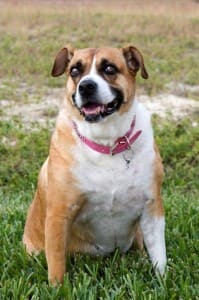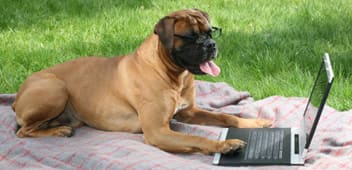October 4th, 2012
For Dogs, Thin is In!
It is easy for us to put on a couple pounds and not notice it until we try wearing something we haven’t worn for a while. It’s even harder to notice small weight gains in dogs. So how do you know if your dog is overweight? Here are some ways to tell.
- Run your fingers along your pet’s rib cage. The ribs should be felt easily and the skin should glide over the ribs smoothly, as opposed to sheets of fat and skin moving along the ribs. Also, the bones of the spine, shoulders and hips should be easily felt or visible.

- Stand over your dog looking at his back. Look for a curved indentation in the area of the waist (just behind the rib cage). If you don’t see one, instead you see a straight line from head to tail, or even a bowed-out line along the back, your dog is overweight.
- Look at your dog from the side. There should be tucked up area behind the rib cage and before the hind legs. If you see a straight line or a saggy area in the belly area, your dog is
- Check your dog’s face. A rounded face or folds of skin around the face and chin may indicate your is overweight (depending on the breed).
- Look at the base of his tail. If your dog is overweight, you’ll see extra padding or folds in this area.
You almost want your dog to look “thin”. We’ve had several people say to us they believe their dogs look too thin, when we believe they are the perfect weight. I think the reason for this is because we’ve become accustomed to seeing dogs that are overweight. In fact, as we’ve said before, we’ve read that fat is the new normal. Because of the myriad of health problems weight issues can cause, this is a trend we would like to stop. So if your dog doesn’t look thin, and he “fails” the tests above, put him on a diet and get him some high quality exercise. Remember, for dogs, Thin is In!

